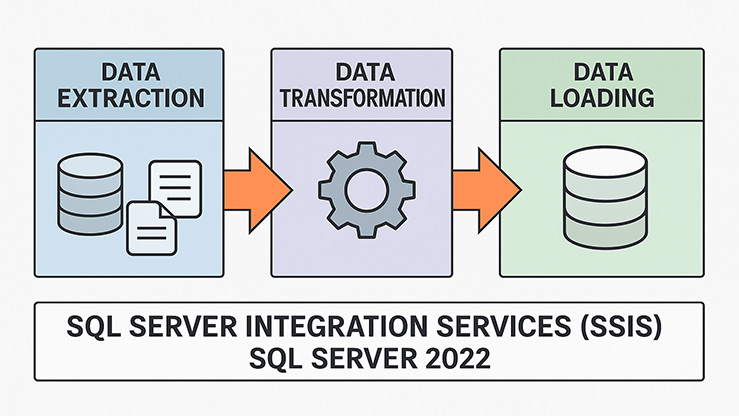| Lesson 6 | SQL Server Integration Services |
| Objective | Identify the key features of SQL Server Integration Services (SSIS) |
SQL Server Integration Services
🚀 Key Features of SSIS
-
Comprehensive ETL Capabilities
- Data Extraction: Retrieve data from diverse sources such as relational databases, flat files, XML files, and cloud-based services.
Example: Extracting data from a CSV file and a SQL Server database.
In SSIS, you can use a Flat File Source component to extract data from a CSV file stored on a local server, parsing columns like customer ID, name, and purchase date. Simultaneously, you can use a SQL Server Source (e.g., OLE DB Source) to pull related data, such as order details, from a SQL Server table using a query like SELECT OrderID, CustomerID, Amount FROM Orders. Both sources can be combined in an SSIS data flow for further processing. - Data Transformation: Perform operations like data cleansing, aggregation, merging, and conversion to prepare data for analysis.
Example: Cleaning and standardizing data during processing.
Using the Data Flow Task, you can apply transformations like the Derived Column to create a new column, such as concatenating first and last names into a full name (e.g., FirstName + " " + LastName). Additionally, the Data Conversion transformation can convert a string-based date field (e.g., "2025-05-13") into a proper DATE data type, and the Conditional Split can filter out rows with invalid data (e.g., null values in critical fields) to ensure data quality. - Data Loading: Efficiently load transformed data into various destinations, including data warehouses and data marts.
Example: Loading transformed data into a SQL Server data warehouse. After extraction and transformation, the OLE DB Destination component can be used to load the processed data into a target table in a SQL Server data warehouse. For instance, cleaned and standardized customer and order data can be inserted into a DimCustomer or FactSales table. You can configure the destination to use bulk insert for high performance or handle incremental updates by checking for existing records using a Lookup Transformation before inserting new rows. These examples illustrate how SSIS facilitates robust ETL processes by extracting data from diverse sources, transforming it to meet business needs, and loading it efficiently into target systems.
- Data Extraction: Retrieve data from diverse sources such as relational databases, flat files, XML files, and cloud-based services.
-
Graphical Development Environment
SSIS offers a user-friendly graphical interface through SQL Server Data Tools (SSDT), enabling developers to design, debug, and deploy packages without extensive coding. This visual approach streamlines the development process and enhances productivity.
-
Control Flow and Workflow Management
The control flow in SSIS allows for the orchestration of tasks and workflows using precedence constraints, containers, and loops. This facilitates the creation of complex workflows that can handle conditional logic, parallel execution, and iterative processes.
-
Data Flow Engine
SSIS's data flow engine is optimized for high-performance data movement and transformation. It supports asynchronous and parallel processing, enabling efficient handling of large volumes of data during ETL operations.
-
Extensibility and Customization
Developers can extend SSIS functionality by creating custom tasks, transformations, and log providers using .NET languages. This flexibility allows for tailored solutions that meet specific business requirements.
-
Robust Error Handling and Logging
SSIS provides comprehensive error handling mechanisms, including event handlers and logging features. These tools help in monitoring package execution, diagnosing issues, and ensuring data integrity throughout the ETL process.
-
Integration with Azure Services
With SQL Server 2022, SSIS enhances its integration with Azure services, allowing for seamless data movement between on-premises systems and cloud platforms. This includes support for Azure Data Lake Storage, Azure Synapse Analytics, and more.

Execute SSIS Packages from Command Line
🛠️ Getting Started with SSIS
- Install SQL Server Integration Services: During SQL Server setup, select the Integration Services feature to install SSIS components.
- Set Up SQL Server Data Tools (SSDT): Install SSDT to design and manage SSIS packages within Visual Studio.
- Create and Deploy Packages: Use SSDT to create SSIS packages, then deploy them to the SSIS Catalog for execution and management.
- Monitor and Manage Packages: Utilize SQL Server Management Studio (SSMS) to monitor package execution, review logs, and manage deployed packages.
SQL Server Integration Services (SSIS) in SQL Server 2022 offers a comprehensive solution for data integration and workflow automation, empowering organizations to efficiently manage their data transformation needs.